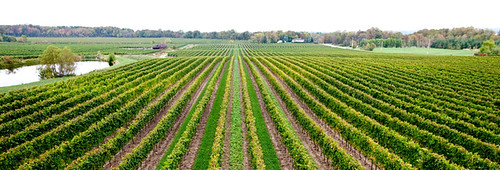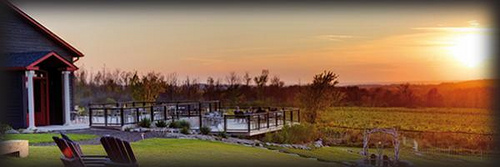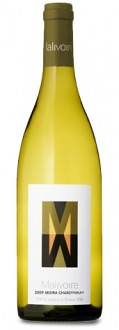
Editor’s note: At the end of July, Earth Scientists Mike Rick and Alex Brunton led a group of geologists to Niagara to explore an age-old question: Is there such a thing as “terroir” in wine and can you taste the distinct geology or minerality in a wine?
The group is driven first by science and second by their love of wine. They visited three wineries in Niagara known for their personable single-vineyard wines to try and find a relationship between the wines and the soil where the grapes are grown.
Their research is far from conclusive and they vow to keep studying this new science with many visits to Niagara in the future. I met up with the group as they were just finishing at Malivoire winery and asked Mike Risk if he could pen something for Wines In Niagara. This is his assessment from that recent visit.
Note: I have also provided a link at the bottom of this post to Alissa Aron’s blog Nobel Route which is a further exploration of this subject based on her reading the post below.
By Mike Risk
Some time last summer, two of us (Mike Risk and Alex Brunton, both Earth scientists), were touring Niagara and sampling the product.
We got into a heated discussion about “terroir,” “minerality,” and the influence of geology on the taste of wines. There is no doubt as to the importance of terroir — it is intuitively obvious that wines from different locations will taste differently.

Minerality is a different kettle of fish. Roots pick up ions, not mineral grains, so when we say we taste “minerality,” we are NOT tasting minerals, but some complex organic compounds that remind us of what we think minerals might taste like. One of the influences of the soil, therefore, lies in the ability of different trace elements, or ratios of trace elements, to stimulate synthesis of organic molecules. And that started us thinking.
On July 27, we organized a Geology and Wine field trip. We had help from Brandi MacDonald, who runs some analytical labs at McMaster while being a PhD candidate in Anthropology. Brandi produced some trace element data, Alex ran soil profiles, and Mike looked at the mineralogy. Our budget was zero, so our data must be seen as a first cut only.
We chose three wineries on the Bench that were known for making fine wines, and also emphasizing terroir: Flat Rock, Tawse, and Malivoire. Thirty people showed up, an eclectic mix including people from four different universities and Niagara Teaching College, amateur and professional winemakers, wine company reps and employees, biologists, and a lawyer — Mike Risk’s brother Stephen.

We started at Flat Rock. Tom and Emma rolled out their terroir series Pinots, from three different vineyards on the property: Summit, Pond, and Bruce. The group all agreed that the wines were different, easily distinguished-and the data could not explain this.
There was some indication that less fertile soils (shallower A horizon) cause the vines to work harder, hence producing better wines. Differences in Barium content of the soils (which are very sandy) suggested some influence of deforestation and erosion of properties uphill from Flat Rock.
At Tawse, Ken Hernder introduced us to the different wines from their Home Vineyard, and Quarry Road vineyard. There were dramatic differences here, but one of the uncontrolled factors was the very high vine spacing at Quarry Road, designed to force the roots deeper into the limestone-rich soil and subsoil. Wonderful wines, each with its adherents.
 At Malivoire, Eric Nixon took some of the group on a tour of the gravity-run winery, and then we all were treated to a series of flights of Chardonnays from the Home Vineyard, the flagship Moira Vineyard, and the vineyard owned by their winemaker Shiraz Mottiar. Again, all the wines were distinctly different, with the data providing little insight. The structure of the Mottiar soil suggests higher clay content, whereas the Moira soil in possibly the highest in calcium carbonate content of any we looked at.
At Malivoire, Eric Nixon took some of the group on a tour of the gravity-run winery, and then we all were treated to a series of flights of Chardonnays from the Home Vineyard, the flagship Moira Vineyard, and the vineyard owned by their winemaker Shiraz Mottiar. Again, all the wines were distinctly different, with the data providing little insight. The structure of the Mottiar soil suggests higher clay content, whereas the Moira soil in possibly the highest in calcium carbonate content of any we looked at.
In the end, we were left with more questions than answers — and some directions for future research.
First of all, all the Bench wineries, being so close to the rocks of the Escarpment, are very rich in carbonate. But, carbonate by itself is not very good at binding organic matter. The soils would be beautifully buffered against changes in pH, which could be a factor because groundwater in the region can have very elevated levels of sulfide.

If there is a secret — and there probably is — it lies in the ability of clay minerals to bind and release organics, which they will do like crazy under conditions of fluctuating moisture and pH. Clay minerals are made up of tiny flakes with powerful edge charges. They can profoundly affect soil structure, and chemicals-especially organics-can be bound to and released from clays. The problem is, the study of clay mineralogy is fiendishly difficult, and way out of the reach of our budget.
In short, we reached no firm conclusions, uncovered no smoking gun-but we all had fun arguing and tasting.
Fig. 1: Soil profiles at the Tawse Home Vineyard, compared with the Malivoire Moira Vineyard. These soils are basically identical-the Moira may be higher in carbonate.
Fig. 2: Trace element profiles of the three Malivoire vineyards. There are only minor differences.
Note: Here is a link to Alissa Aron’s blog on this subject entitled: Minerality and the relation between Intuition and Correlation. It’s a great read and a nice companion piece to the above. You can follow her @nobleroute on Twitter.
Aron is a student in the Master International Vintage program run through the Ecole Supérieure d’Agriculture in Angers, France. During the two years of this Erasmus Mundus masters program, she will spend one semester each in France, Italy, and Spain, and finish with a 6-month internship somewhere in the world. The program is broadly focused, covering marketing, viticulture, and enology.






Comment here